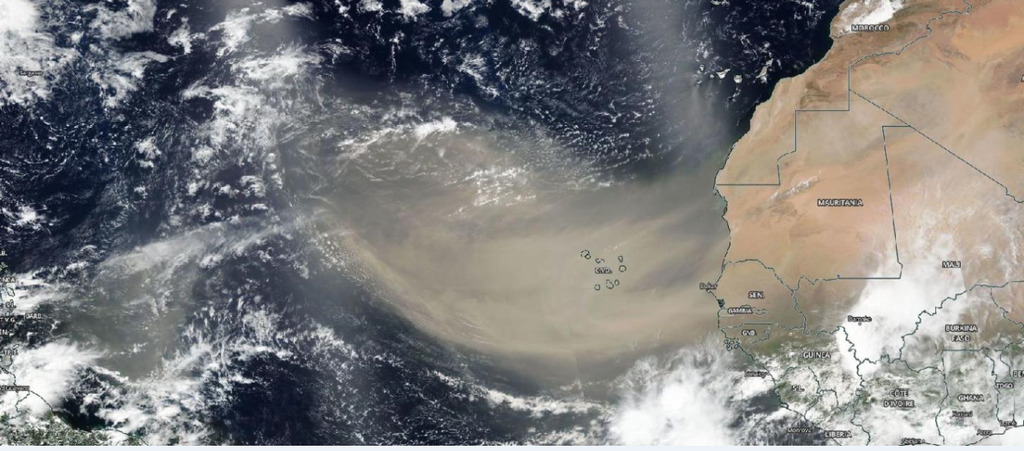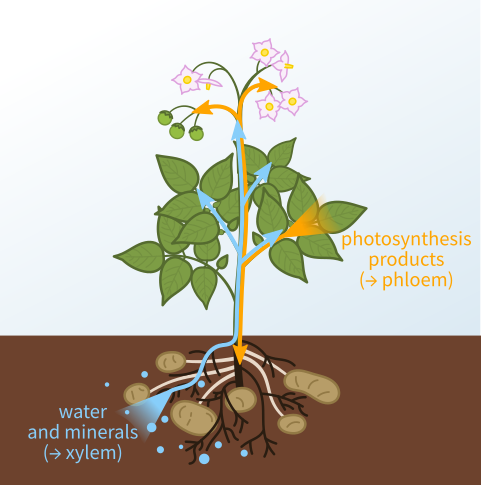In my blog post last month, I mentioned the likelihood of having a very active Atlantic tropical season, especially because the ocean surface temperatures are so warm. But despite an early start to the season with the first three named storms (including Beryl, the earliest ever category 5 storm in the Atlantic Ocean), it’s been quiet for the last few weeks. The ocean temperatures continue to be very warm. What is preventing the development of tropical storms in such a warm environment? One of the main culprits now is Saharan dust that blows west off the African continent and affects the vertical structure of the atmosphere. This keeps tropical waves from developing the necessary circulation to strengthen into a powerful storm. In this post, we will discuss the impacts of the Saharan dust and how it is both good and bad for the environment.

What is Saharan dust and where does it go?
The Sahara Desert covers most of the northern portion of the African continent. It’s the world’s largest source of wind-blown dust supplied to the ocean and adjacent land. It is one of the driest places on earth and is covered with sand and rocks but very little plant materials. This means the dust from the Sahara is mineral dust with low organic content. Seven elements (Ca, Mg, Al, Ti, Fe, K, and Na) account for 98% of the total analyzed inorganic burden. The dust particles are often very fine, so they can travel a long distance from their source region on the continent.

Winds in that part of the world blow from east to west near the surface. You might know of them as the “trade winds”, which are often described in elementary geography classes as the winds that helped European ships travel west to North America. The trade winds form a band of westward-blowing winds from about 30 degrees south to 30 degrees north latitude around the globe. The strength of the trade winds changes over time, but when they are strong and a lot of dust is available over the Sahara, the particles can blow all the way across the Atlantic, covering large parts of the Atlantic and bringing low air quality and beautiful sunrises and sunsets to people in its path. This month has been particularly dusty, with satellite records showing this is the 2nd dustiest July since continuous records began in 2002. Generally the dust plumes occur at a height of 5,000 to 20,000 feet where the trade winds are the strongest.
How does Saharan dust affect tropical storm development?
The air that carries the Saharan dust is usually very dry, which disrupts the usual moist conditions above the ocean surface and keeps thunderstorms from growing vertically. The vertical air movement would normally help initiate the decrease in surface pressure that helps storms grow. The dust particles also serve as nuclei to absorb even more moisture from the air, keeping the layer dry. The dust is opaque (which makes it visible from satellites) and shades the surface of the ocean, cooling it off and reducing its ability to energize storms.

The Saharan dust layer is most likely to occur in the period between mid-June and mid-August, but there are variations over time and location because of the strength and direction of the wind. Sometimes the winds even blow from south to north, bringing dust to Europe, although this is less frequent. Tropical storms can sometimes form in pockets of relatively dust-free air, as Hurricane Beryl did this year, but the thickest layers are very effective at shutting down storm growth.
How does the dust affect air quality and human health?
Saharan dust incursions into the Southeastern United States can often been seen in air quality measurements taken in cities around the region. Like any other dust particles or other aerosols like smoke from forest fires, the particles can trigger asthma, burning eyes, and other symptoms associated with bad air quality. The dust can be seen in lower visibility around the cities, deposits on horizontal surfaces like cars and plants either directly from the dust or from “dirty rain” which contains the dust and brings it down to the ground. It can also result in spectacular sunrises and sunsets due to the scattering of the sun’s rays by the particles (similar to those from volcanic eruptions). If you are sensitive to poor air quality and plan to work outside in your garden, you will want to monitor air quality carefully and avoid the times when the pollution is worst.

How does the dust affect plants?
Saharan dust has important positive impacts on both phytoplankton in the ocean and on the Amazon rainforest. Those areas are often missing nutrients that would allow plant growth and so additions of iron and phosphorus into those areas can improve soil or water fertility and plant growth. Unfortunately the dust can also contain bacteria or other organic material that can lead to undesirable growth of algae in the ocean. The dust is not acidic, so acid rain is not something we worry about with rain containing the Saharan dust, unlike rain from volcanoes or from coal-burning power plants. The dust can also reduce absorption of sunlight by plants if there is a large amount.
How can gardeners prepare for episodes of Saharan dust?
First, we need to recognize that while we have not studied Saharan dust impacts for long, it has been around for many years and is a natural part of the earth-atmosphere system. It has beneficial impacts on soil nutrients in tropical rainforests and gardens in the affected areas and helps reduce activity in the tropics early in the season. But with dust events decreasing in the next few weeks, we can expect the Atlantic tropics to start heating up again as the most active part of the season gets underway. Gardeners should monitor their plants for dusty conditions and should also keep track of air quality impacts if they have asthma or other breathing disorders that could be affected by the dusty conditions. Gardeners in other parts of the world should also be aware of sources of dust and other pollutants that could affect their gardens and their own health. The Garden Professors blog has discussed the impacts of dust on gardens in several of our previous posts so please search for them if you want more information.







